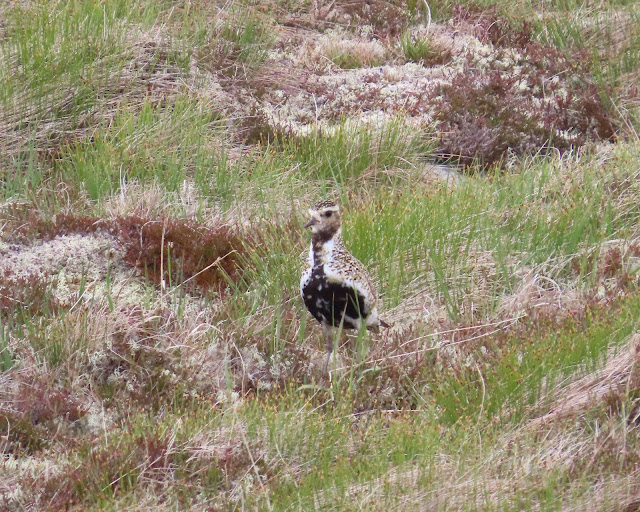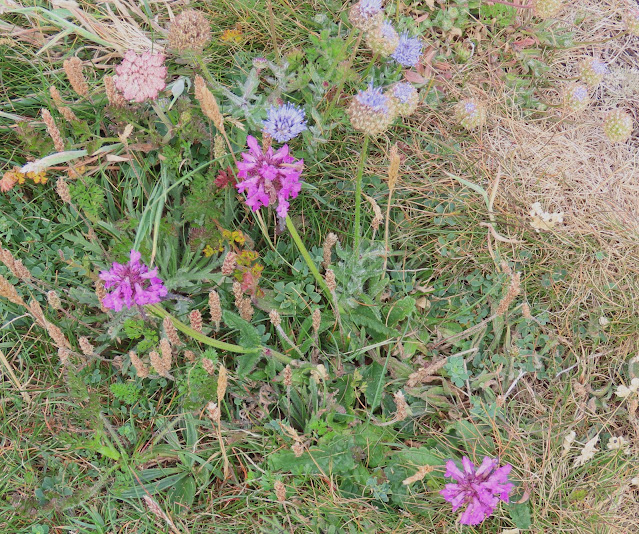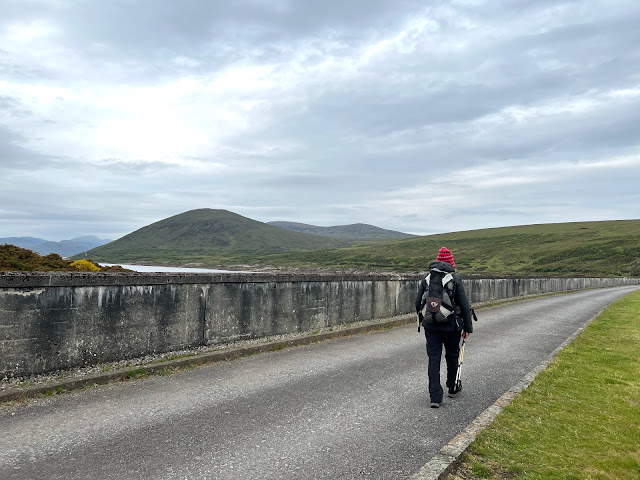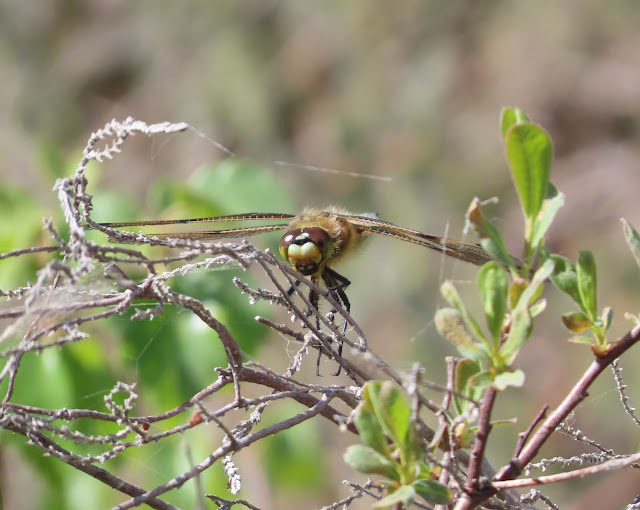Saturday, July 05, 2025
It's wet and windy today, and by late afternoon I was going mad - so I drove to Ardmair for a short walk on the beach. As I got back to my car, a herring gull flew over - closely followed by a bonxie. Oh well, better than nothing.
Yesterday was also wet and windy, so I put my waterproofs on and did the old lockdown walk, along the river paths, round the spit, through the campsite, past the harbour, and then up the hill and home. A barrel jellyfish was beached on West Shore.
I have finally identified two wildflowers I found in Cornwall. The purple one is betony, and the blue pompom-type ones are sheepsbit scabious. I think.
I did some research on the loose dog by the A9, and found that the dog was found okay. It's a "rescue dog" - a "lovely boy" - and "something spooked it", apparently. Well, if it spooks that easily, how about keeping it on a lead? Neither the owners nor the finders (nor anyone else who commented on the incident without having been there) seemed to have any concerns at all that the dog was feet away from fast traffic, and could have caused an accident. The world has gone dog-daft.
Thursday, July 03, 2025
We set off for Cornwall on Thursday 19th June, breaking our journey for the night at Tebay West. It was really hot, right into the evening, and I revelled in walking out behind the hotel before dinner in thin trousers and a T-shirt. At last we were going to get some of the heatwave that the south was enjoying - or so I thought.
Greger had all the charging stops worked out; this one was in Lifton, near Launceston.
An early visit was to Land's End, although we'd once sworn never to go there again! It's now £8 to park - however short your stay is going to be; while further money will be extracted from you by the shops and the various "experiences" if that's what you want. But you can walk away from all this tat and enjoy the crashing of the sea and the grandeur of the granite cliffs - while the presence of choughs came as a nice surprise.
The roped-off path had diversion signs at both ends. I'm not sure if this was to prevent disturbance of the choughs, as the sign we saw didn't mention them; but even if it had mentioned them, no doubt those people who were manoeuvring themselves past the barriers and walking the path anyway would still have done so.
On a rainy morning, Greger suggested a visit to the King Edward Mine Museum near Camborne, where we had a guided tour. It was very interesting; I hadn't known that copper was also mined in Cornwall, and was actually removed first as it's closer to the surface than tin.
Our holiday let was a small but spotlessly clean property near Nancledra, between Penzance and St. Ives. You need to negotiate stretches of single-track road whichever direction you take, and getting to the large car park above the town would involve even more. Greger had the idea of driving to St. Erth where there's a large park-and-ride, and catching the train to St. Ives - and we ended up doing this several days in a row, walking through the town (pausing to buy hot Cornish pasties on the way) and then along the coastal path to Clodgie Point.


Neither of us felt like walking far, and an attempt to get to a trig point quite a bit further along the coastal path was called off when we realised we were just too tired! I didn't mind - I was happy to do some sea-watching, while Greger was content to help me spot birds or just lounge around - or go for short walks when he felt he was being too lazy! It was sometimes sunny, but there was an irritating and quite cool westerly wind (sounds familiar!) for the whole week. We saw hundreds of Manx shearwaters heading west, mostly quite far out. I think you really need a telescope to sea-watch properly.

Also seen seawards from Clodgie - a flypast little egret, a family of Sandwich terns, and a kestrel pointed out by Greger; while my first whitethroat of the year was in the bracken behind us, along with a sedge warbler. A family of linnets whizzed about, and a rock pipit carried food to a fledgling down on the rocks; but a chiffchaff (surprising in a scrubby area with no trees) was heard only.
On our last day, we walked over to have a look at Man's Head.
Something that looked vaguely orange was buzzing about so fast that we could hardly follow it - we had caught a glimpse of one such insect at Clodgie, and been unable to stay on it then. Now, it occurred to me that it must be a hummingbird hawkmoth. There were at least three individuals, zooming around and seemingly investigating nooks and crannies in the rocks, but never settling. I googled about this behaviour, and AI Overview suggested that while hummingbird hawkmoths might act in this way, it certainly isn't a common sight, and perhaps the insect in question was a different moth or even a different insect altogether. Well, AI Overview, I did manage to catch one of them in its manic flight, and poor though the photo is, we are definitely talking hummingbird hawkmoth!

The morning we booked out of our holiday let it was raining - and the rain persisted until we had left Cornwall behind. By the time we reached Hilton Park services, north of Birmingham, it was sunny and warm - and while Greger charged up (it was too hot for him) I walked about soaking up the sun.

We saw no accidents on the way home (two on the drive south on the M5) which was nice, but there were two disconcerting incidents. A motorbike came up very fast in the slow lane as a car ahead in the fast lane switched to the middle lane we were in. The rider swung out in front of us, and veered into the fast lane to pass that car, in front of a car that was passing us - which had to brake. He was the first in a small group of bikers, but the others were not quite as reckless, thank goodness. The second incident was just south of Perth on the A9. What I thought was a dog came running along the grassy verge, parallel with the road, against the flow of traffic. The car's dash cam and side camera caught it, and prove it was a dog; but for what looks like a collie or sheepdog type, it has strangely short legs.
The dog was almost galloping, as though it was desperate to get somewhere - so we can only hope it got there safely.
We enjoyed our holiday. It was particularly nice to be in St. Ives again, as we haven't been there since 2009; but I have to admit there was no heatwave, and our swimsuits came back unused.
Wednesday, June 18, 2025
Two days ago I was putting stuff in my car, aware of a large sparrow family active in the rowan tree and on the lawn below, when something white caught my eye and I straightened up, ready to shout at a certain white cat that hunts with annoying persistence in our garden (I'm not a cat lover). But on this occasion it was a herring gull. It grabbed one of the sparrows and took off, flying over me and out of sight.
We can see a nest with two chicks from our back window, although I'm not sure that's where this particular gull was heading.

It's well-known that herring gulls nest on rooftops, but I've always supposed that the parents still hunt for food on the sea and shore (or scavenge from people); I hadn't expected to see one predating a small bird in the garden. Last year, we watched this nest as a single chick grew and finally fledged, glad that the gulls had chosen a house rather than a bungalow as this puts a bit of distance between the birds and the residents. However - when I went out the back to hang up washing, there was a herring gull on the neighbours' roof, making a real din. Before I could think what this might mean, I felt a sudden rush and heard a whoosh as a second gull buzzed me - fortunately, without making contact. Greger came out and spotted the chick on our roof - from where the parent had launched its attack. The juvenile loitered for a while, and was later seen on the pavement outside before disappearing again. A few days later, I saw a dead juvenile herring gull on the side of the road as I drove to Tesco - maybe the same one, maybe not. It would be better if they gravitated on fledging towards the harbour, which I suppose many do; and oddly enough, when an adult is present on the nest we're watching, it's almost always facing the other way - out to sea.
Wednesday, June 11, 2025
Meall an Torcain
We set off across the dam towards this hill (closest to the loch), hoping to carry on from its summit to the two further, higher tops.
On the col between those two I once snapped fruiting cloudberry - and although I've seen plenty of cloudberry since, none bore fruits; while on the same walk, approaching the summit of Tom Ban Mor, I heard a dotterel. So I was hoping for great things. It started well; the hydro track from the dam to the second gate gave us several birds, starting with a male reed bunting which I didn't manage to snap - and two distant red-breasted mergansers.
There were several willow warblers and a family of redpolls.
On the wettish flank of the hill there were meadow pipits, while a calling red grouse was flushed from the long grass. This was Greger's first visit to this top (and, given the steep, boggy, pathless struggle to get here, possibly his last).
On my two lone ascents, I'd found the top deserted and peaceful; not so this time. Something was running on the skyline near the further top - a male golden plover. It started to alarm-call and came running in little bursts towards us. Oh dear - where was the nest, where were the eggs or the chicks? Two adult birds were now in a panic, circling us at a distance and calling continuously, now and then taking to the air and flying past and back again; and to make things worse, a red grouse erupted noisily from the plateau and disappeared over the edge of the hill - possibly the same bird we'd already disturbed once. Oops.


We weren't very popular on this hill-top - but we had to cross it if we intended to continue, so we walked quickly over and then surveyed the terrain ahead. The two tops looked a long way away, and the spur I'd wanted to follow was rough and peat-hagged, making a deep dip before the final ascent to Tom Ban Mor - and even then we weren't sure we could get up that way. It looked extremely steep. We decided against it, and headed back to the main summit. Cue more panic from the plovers. As they were now converging with us, I stopped to snap the female against the loch, and Greger said he spotted a third bird - a chick or juvenile, perhaps.
He took a picture of the wind-farm....
.....and one of me, my head framed by Ben Wyvis.....
....and we dropped down from the summit, finding a useful ledge for lunch. The male plover did a last (silent) flypast and seemed content that we were no longer any threat, as we saw and heard him no more. As we sat there I heard the lovely call of a curlew and Greger said it must have been the bird he saw flying across the loch towards our hill. I didn't see it, but I said it would go on the list - along with a cuckoo, heard only from the plantations across the road.
The warm sunny weather we'd been promised broke through as we descended, and there was some stripping off of various layers. Gaining the hydro track, I looked back up the hill to see a red kite in the sky and then a pair of common gulls. The dam gave us house martin, raven, and pied wagtail - making 14 species of bird in all, which is a very respectable total for such a small hill.
Friday, May 30, 2025
"If you get into the world of weevils, you're going to be confused for a hundred years" - Greger's somewhat distracted comment when I complained that on-line info concerning this tiny creature wasn't straightforward.
I think it's
Otiorhynchus atroapterus - but whether the common name is dune weevil, sandcrawler weevil, or black marram weevil is anyone's guess. Anyway, it was spotted on the beach at Achnahaird, and gave me a new species on yet another visit with no waders to speak of. On the drive out, we stopped at the plantation and I walked back to the bogbean pool just to check for dragonflies, as the bogbean is almost finished now. Two snipe erupted from the soggy verge of the pool, zoomed low over the moorland, and dropped to the ground again just beyond the skyline.
Two days ago: The mountain avens were on a ledge off the main path at Knockan Crag, and I got as close as I dared on spongy, grassy ground above a steep drop in a maniacal wind - only to find that the flowers were past their best.
But what were those strange feathery things towering over a second patch of the flowers (or at least their distinctive leaves)? Looking it up at home I learnt that they are the mountain avens after flowering - the silky twists later opening out to carry the seeds off on the wind. Amazing. I'm so glad I saw them.
.jpeg)
The day before that we drove down the coast to Inverewe and took a walk through the woods. We've seen spotted flycatcher here in the past, but now only willow warblers, chaffinches, and goldcrests were evident - all three heard but not seen. There was nothing on the beach or the sea. My spring birding isn't going well. On the way home, we pulled into the lay-by at Gruinard beach, where we discovered that you get an hour's parking free - and then it's only an "invitation" to pay. Once again, I'd moaned on my blog about something before finding out the facts! Oops. In the field behind, I found a few ragged robins just coming into flower. Some time later, near the Fannichs' car park, I walked down to the little pool where bogbean grows - but it was mostly going to seed, with the few flowers left being of the thrum form. In the Coigach area, I'd noticed this year that the bogbean in the larger pool behind Badentarbat beach were mostly, if not all, of the thrum form, while those in the little roadside pool where I first saw them were all of the pin form. I also have to correct myself in thinking that pin and thrum simply meant each flower was either male or female, as bogbean are bisexual; but it does depend on which part of the flower is longer - the female in the pin form, male in the thrum.
You live and learn. And the more I learn about plants, the more fascinating I find 'em.
Thursday, May 22, 2025
A female azure hawker was basking in the sun, just below the upper quarry.
This was a welcome sighting as I didn't manage to encounter any azures last year. A second dragonfly zoomed in and buzzed it, and off it flew, not to be seen again. I think the buzzer was a four-spotted chaser.
We had coffee and biscuits at the top of the climb, with grey wagtails and dippers busy on the river below. A juvenile dipper was spotted. As we walked back down the dusty road, an unseen cuckoo entertained us with its slightly out-of-tune call; but once again, no spotted flycatchers or wood warblers were evident.
Yesterday: A beluga whale was reported (and briefly filmed) in Loch Broom! This gave me a focus for the day, and I drove up the loch to a lay-by beyond the salmon farm and then made my way slowly back to the village and West Terrace, meeting various other people also on the watch. We were unlucky - but the fact that the whale appeared to have headed back out to sea perhaps suggests that it wasn't in trouble, anyway. (Info from Shearwater Cruises, Ullapool, on Facebook.)
Three days ago I remarked to Greger that I'd always fancied the near end of Loch Glascarnoch for Temminck's stints if the water level was low - so off we went. We could see no stints, but were happy with ringed plover (5+), a common sandpiper, and a very close dunlin.
Making our way back up to the road, I noticed how the messy, bouldery area that's usually under water has become colonised by plants, including sundew.
I also identified what I think was a variety of clubmoss, while tiny bog myrtle bushes were everywhere.
I've used a semi-colon in this post, in protest at reports that this punctuation mark is dying out, with lots of silly talk about pretentiousness. Semi-colons simply help the reader to understand the meaning of, and fluently read, a piece of text. In the same article I read that some people refuse to use the full stop, on the grounds that it seems abrupt and therefore rude. FFS. Instead, they use much more annoying endings for their sentences, such as irritating emojis - especially those blooming bobbing ones which drive me mad - or several exclamation marks, aptly known in the newspaper industry as screamers.
Thursday, May 15, 2025
A warm dusty walk up the quarry road as far as the river brought sightings of narrow-bordered bee hawk-moths - a single one at the top of the road and two at the bottom, near the lower quarry (or sorting yard).
A green hairstreak butterfly was a first for the quarry road. At one point I heard the sudden softish but explosive call of a female cuckoo - often described as "bubbling", though to me it sounds a bit like "wi-wi-wi-wick". I didn't see the bird, although later I would glimpse a cuckoo in swift and silent flight across the river gorge.
Yesterday: Walking round the side of the dunes at Achnahaird we noticed the five whimbrel at the same time - and too late not to put them to flight. They skimmed the tops of the dunes and seemed to dip down again, so I don't think they went far.
We'd crossed the machair where the pink tufts of thrift were just breaking through and seen nothing, when a flock of small waders went careering past, low down, towards the sea. Where had they come from?! I hoped they would land, but they kept on going. Greger last saw them banking round the headland towards Garvie Bay, and they didn't return. Tantalising. At Badentarbat there were ringed plovers, oystercatchers, one unseen dunlin, one great skua, and a pair of common sandpipers.
I've finally identified the fly on the rock, seen during our hill-walk three days ago, as a deer warble fly (Hypoderma diana). It's from the same family as the bot fly, which is more commonly known as deer nasal bot; but the warble fly lays its eggs on the back of the animal rather than in the nose. Warble fly is a notifiable disease, in cattle at least (info and photos on naturalist.org and Flickr.com).











.jpeg)












.jpeg)







